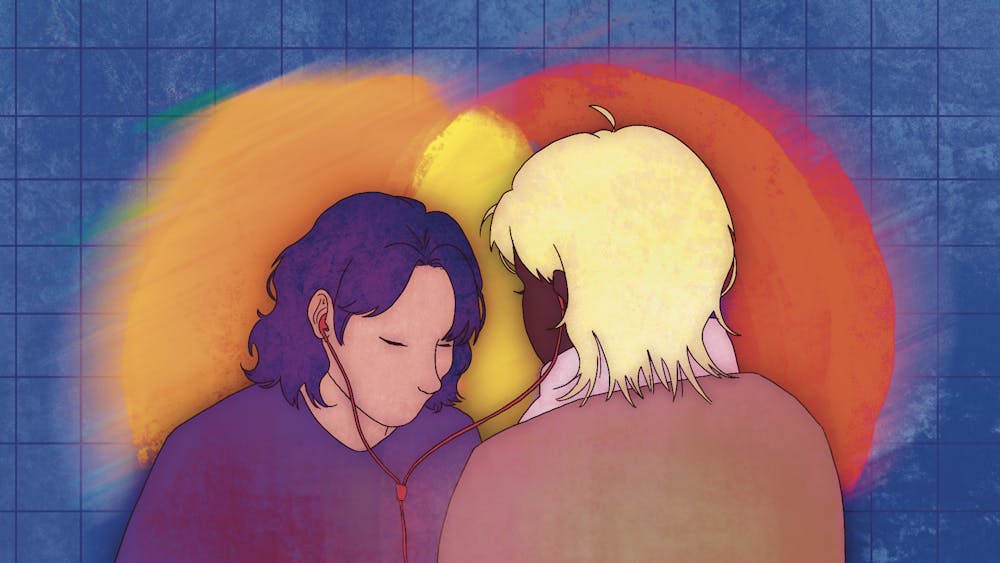With the arrival of Valentine’s Day, it’s time to ask: How do you say “I love you”? Well, other than in those words exactly. A box of chocolate–covered strawberries? A handcrafted card? An all–expenses–paid surprise vacation? (Maybe not that last one if you’re a college student.) If you’re lost, there’s even a very popular theory of five “love languages.” For a time, the mixtape was the pinnacle of thoughtfulness and accessibility in gift–giving. Burning a CD or packing a cassette with songs that perfectly described one’s feelings for their loved one was not only inexpensive but also seen as an art form. Nostalgia for this artifact of the past persists; mixtapes feature even in relatively recent films as a symbol of love. With the rise of music streaming services, it seems the art of the mixtape is dead. But Spotify Blends might be the 2020s’ adaptation of a beloved tradition.
Music arguably found its most successful initial social–media–fication through Spotify. Beyond its huge library of streamable music, Spotify stands out due to its interpersonal capabilities. Each user has an online account complete with a username and profile picture, may follow friends and artists, and can like and save others’ playlists. In a world dominated by iTunes, Spotify’s unique characteristic was its aim, similar to platforms like Instagram, to connect people online through their interests—in this case, musical ones.
Originally launched in 2021, Spotify Blends promises to deliver just that within the space of a playlist. Aptly named, a “Blend” generates a combination of the tastes of up to ten users. It, along with Spotify’s Friend Mix, falls under their category of playlists with “social recommendations,” meaning that Blends include songs Spotify thinks users “might like based on their listening activity” and update with new additions daily. But how do Blends actually work?
The magic mechanism behind the Blend is an algorithm. In its creation, Spotify’s engineering teams sought to balance four attributes: relevance (the inclusion of songs that have been listened many times, and not just once, by users), coherence (a playlist’s “flow”), equality (similar representation between users), and democracy (the presence of “overlap” music between a Blend’s participants). Spotify deliberated between two main goals in generating these playlists: in their own words, either to “maximize the joy” or “minimize the misery.” According to Spotify, we should think of it as a Venn diagram. If each user’s musical taste is a circle, the overlap is the music they both like. Minimizing misery would mean prioritizing this area within the playlist. Maximizing joy, meanwhile, focuses on including each user’s actual favorite tracks—either side of the Venn diagram. Each Blend clearly implements this setup, as there are three types of tracks: In a two-user Blend, we have User One’s favorites, marked by their profile picture; User Two’s favorites, marked by theirs; and the songs they both listen to, designated by the profile pictures side by side. Ultimately, the team decided to “maximize the joy” by valuing relevance. This approach, according to Spotify, allows more flexibility with user pairs who have very little listening history in common.
All of this sounds great on paper; after all, Spotify calls Blends both “automatic” and “personalized.” But do they really fulfill the latter? One Reddit post critiques their functionality, noting that, from their experience, Blends isn’t quite as up–to–date on what users are actually currently listening to, instead incorporating songs they listened to months ago. There’s also the fact that it’s so low–effort—perhaps both a benefit and, in a sense, a shortcoming. Can Blends really be today’s equivalent of crafting a mixtape for someone if they’re compiled by an algorithm and not by ourselves? Spotify’s collaborative playlists, where users can essentially share the same capabilities of adding, deleting, and reordering tracks, seem like a truer modern take on the mixtape.
At the same time, there’s something to be said about the physicality lacking on streaming platforms like Spotify. A CD, as any older Gen–Zer knows, is all too tangible. Prone to scratches you don’t realize are there until the music skips a beat, stacked in cracked plastic cases or inserted in the pages of a book–like case, the compact disc is an experience of its own. Though online playlists are much speedier to assemble, they are also much easier to be rid of altogether. In the event of a breakup—romantic or platonic—deleting shared playlists is easy. But a CD or mixtape is harder to throw away. (The same can be said about texts and emails in contrast to handwritten letters and cards.) Spotify Blends are still a similar expression of love and shared interests, but a CD is like a moment frozen in time. Though the bond between its creator and the person who received it might have changed, the tracklist remains exactly the same, capturing the nature of their relationship the day the disc was marked with a message in Sharpie.
As physical media continues to experience an immense uptick in popularity. However, we shouldn’t rule out the possibility of a return to our roots. The LP, which turned 75 in 2023, has seen an increase in sales for 17 straight years. In 2021, American CD sales rose for the first time in nearly two decades. This trend may be due to a desire for real ownership of music and support of artists. But this shift might also simply be thanks to the charm of physical media as a chance to disconnect from the internet—and thus, our phones, computers, tablets, and even, at this point, watches. Maybe Gen Z is so “chronically online” that we’ll soon seek a mass exodus from what that means for our music, and more importantly, our relationships. Though we can’t completely divorce ourselves from technology, leaning away from automatically generated playlists and time spent online, we can seek refuge in a less advanced digital world—capturing a joint personal moment in time with those we love.

